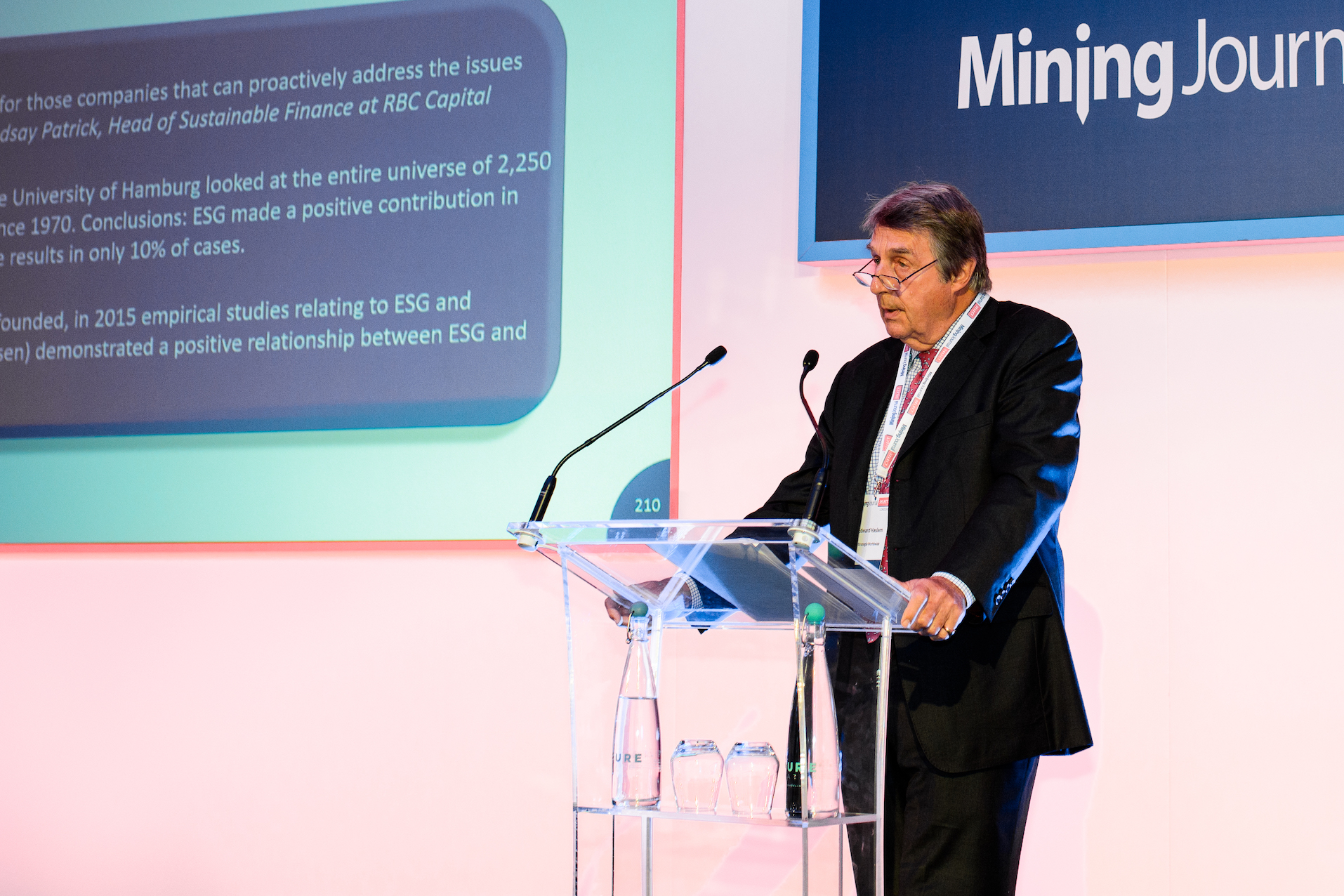
At the recent Mining Journal Select event, Strategia Worldwide’s Head of Mining, Edward Haslam, presented on ‘The Environmental, Social and Governance(ESG) Funding Revolution’. Edward, Deputy Chairman and Senior Independent Non-Executive Director at Centamin and former CEO of Lonmin was joined during the Q&A, by Strategia’s Associate Director, Peter Whitbread-Abrutat, an expert in ESG, and an IEMA Lead Environmental Auditor with extensive and diverse experience of mining-environmental and social audits. The presentation addressed three key questions:
1. Can funding be secured in today’s climate without ESG compliance?
2. Is ESG a cost or a value add?
3. How can investors assure themselves that a potential investment is ESG compliant
“If you had asked me, as CEO Lonmin, if was interested in ESG, I’d have probably said my priority was digging for minerals, getting it onto the market and satisfying the shareholders. Now, the requirement to have permission to dig, which is what ESG is all about, is fundamental. So, to describe me as something of a poacher turned gamekeeper would be uncomfortably near the mark.”
Edward Haslam, Partner and Head of Mining
Tom Albanese, former CEO of Vedanta Resources and former CEO and a board member of the Rio Tinto Group, gave a good summary of the two day conference drawing attention to the increasing importance and magnitude of ESG risk. Tom linked this to the increasing difficulty of securing Social Licence to Operate (SLTO) and also encouraged the independent validation of ESG compliance by investors “Investors need to have their own way of believing it (ESG compliance)… managing, tracking and asking miners the right questions.”
Summary of Presentation
1. Can funding be secured in today’s climate without ESG compliance?
NO!
There is an increasing awareness that climate change is a reality and whether you believe this or not, recent media coverage of Greta Thurnburg and David Attenborough are influencing public opinion and investment decision making. As a result the public is holding Companies to more and more exacting standards. In our mining world recent catastrophes now serve to highlight the critical importance of getting ESG right if Companies are to attract investment and retain their social licence to operate.
In Blackrock’s New Year end letter to CEOs, Larry Fink stresses the importance of adhering to ESG standards if investment is to continue.
“the global landscape is increasingly fragile and therefore susceptible to short term behaviour by corporates and governments alike.”
“Companies that fulfil their purpose and responsibilities to stakeholders reap rewards over the long-term. Companies that ignore them stumble and fail. This dynamic is becoming increasingly apparent as the public holds companies to more exacting standards. And it will continue to accelerate as millennials – who today represent 35 percent of the workforce – express new expectations of the companies they work for, buy from, and invest in….”
Larry Fink, CEO Blackrock
The World Economic Forum also states that ‘environmental and societal risks have now overtaken economic and geopolitical risks in terms of both likelihood and impact. While many mining Companies have taken these considerations on board and incorporated ESG discipline either at board or exco or in some cases both, Edward suggested that the industry as a whole still has some way to go in this respect.
Whether you are a ‘start up’ mining Company seeking investment or an established listed Company looking to protect value, ESG awareness and compliance is now an imperative at the highest level in the Company. Non compliance will make it harder, if not impossible, for our industry to attract capital and taking a wider view, to secure capital for the supply of the raw materials that underpin every facet of modern life from mobile phones to automobiles.
In summary competition for investment will require companies to move beyond compliance – they will need to demonstrate to investors that they are adopting ‘best practice’ that extends beyond well beyond ‘box-ticking’.
2. Is ESG a cost or a value add?
The approach to ESG will reflect the culture of the Company. If an organisation works in a number of silos, which many Companies do, effective management of ESG risks will be compromised. The greater the organisational effectiveness, the lower the level of risk exposure and this will be rewarded by shareholders and stakeholders. On the cost side Companies are now required to deliver increased transparency on an ever expanding range of metrics including but by no means limited to -: the Bribery Act, Modern Slavery, Disclosure of Gender Pay Gap, New Corporate Governance Code, Global, Reporting Initiative, IFC Performance Standard… and many more!
On the broader horizon there is now the need to ensure that primary supply chains are compliant with basic international standards and conventions. Responsible stewardship must be demonstrated in order to secure access to land and water. On the latter a fairly recent Morgan Stanley research paper estimated that de-salination adds opex of around 92 cents p/mt of copper mined in S.America.
But what are the consequences of not complying with ESG ?Post closure mining sites must be physically and chemically stable so that they are available for safe and sustainable future land use. These are clearly forces for good and it is entirely understandable when Aberdeen Standard Investments recently advised that in the longer term they anticipate an increasing amount of their investment flows will be channelled into strategies that incorporate ESG. The value added is therefore in compliance. Whilst failure to address ESG is a risk management issue, the converse is equally true; so for enlightened Companies properly managed ESG becomes a substantial value add. The message is clear: proper risk management generates opportunities and is good for business.
There is plenty of evidence to support the view that ESG is a value add:
- Lindsay Patrick, Head of Sustainable Finance at RBC Capital has stated that ‘You will see a lowering of the cost of capital for those companies that can proactively address the issues that ESG investors want them to look at.”
- A survey from Deutsche Bank and the University of Hamburg , looked at all the academic studies on ESG published since 1970c and concluded that ESG made a positive contribution in 62.5% of meta studies and produced negative results in only 10% of cases.
- The largest empirical study, looking at the relationship between ESG and financial performance, by Friede, Busch and Bassen, concluded that the case for ESG investing is empirically well founded with a positive relationship between ESG and Corporate Financial Performance (CFP)
3. How can investors and stakeholders assure themselves that a potential investment is ESG compliant?
Major environmental disasters; fatalities; corruption and bribery allegations; allegations of human rights abuses; polluting production all form a part of the global miners’ role of shame. These are instantly and highly visible in the current social media world and as a result some of the big diversified mines have become difficult to own by a swathe of institutional investors.
So, what steps can an investor take to assure themselves that a potential investment is ESG compliant? A strong ESG committee with executive powers will go a long way towards avoiding environmental disasters. One difficulty here, is the absence of a universally standardised norm against which such judgements can be made. However, the IFC provides the closest thing to a ‘gold standard’ for mining companies but in addition to IFC compliance, investors should also be asking:
1. Have ESG risks been fully understood?
2. Are there integrated, robust plans in place to manage it?
3. Is there a control framework, linked to the risk assessment, in place
4. Have those plans and controls been tested?
5. Is there independent oversight?
Answers to these questions will adequately demonstrate how stakeholders and investors can assure themselves that a potential investment is ESG compliant and why Companies should look for third party independent assurance. Investors are more likely to trust you if you have not marked your own homework.
- Mining Journal Select 2019
- Edward Haslam ‘The ESG Funding Revolution’
- Edward Haslam and Peter Whitbread-Abrutat
- Edward Haslam, Head of Mining, Strategia Worldwide and Edward Cory, Managing Director, Proudfoot
- Ian Pickard, co-founder SW, Edward Haslam, Head of Mining, SW and Tom Albanese, Former CEO Rio Tinto Group and Vedanta Resources












Responsible investing is widely understood as the integration of environmental, social and governance (ESG) factors into investment processes and decision-making. ESG factors cover a wide spectrum of issues that traditionally are not part of financial analysis, yet may have financial relevance. This might include how corporations respond to climate change, how good they are with water management, how effective their health and safety policies are in the protection against accidents, how they manage their supply chains, how they treat their workers and whether they have a corporate culture that builds trust and fosters innovation.